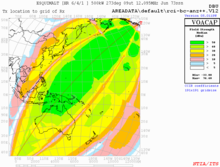|
Curtain array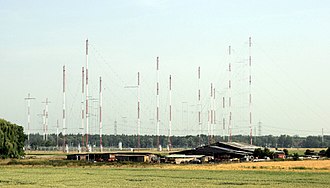 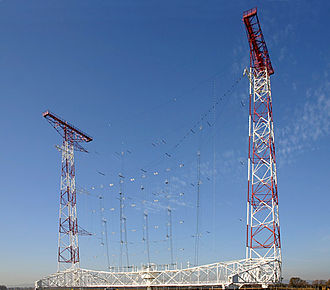 Curtain arrays are a class of large multielement directional radio transmitting wire antennas, used in the short-wave radio bands.[1] They constitute a type of reflective array antenna, consisting of multiple wire dipole antennas, suspended in a vertical plane, often positioned in front of a "curtain" reflector made of a flat vertical screen of many long parallel wires.[1] These are suspended by support wires strung between pairs of tall steel towers, reaching heights of up to 90 m (300 feet) high.[1] Primarily employed for long-distance skywave (or skip) transmission, they emit a beam of radio waves at a shallow angle into the sky just above the horizon, which is then reflected by the ionosphere back to Earth beyond the horizon. Curtain arrays are extensively used by international short-wave radio stations for broadcasting to large areas at transcontinental distances.[1] Due to their powerful directional characteristics, curtain arrays are frequently utilized by government propaganda radio stations to beam propaganda broadcasts across national borders into other nations. For instance, curtain arrays were used by Radio Free Europe and Radio Liberty to broadcast into Eastern Europe. HistoryCurtain arrays were originally developed during the 1920s and 1930s when there was a lot of experimentation with long distance shortwave broadcasting. The underlying concept was to achieve improvements in gain and/or directionality over the simple dipole antenna, possibly by folding one or more dipoles into a smaller physical space, or to arrange multiple dipoles such that their radiation patterns reinforce each other, thus concentrating more signal into a given target area. In the early 1920s, Guglielmo Marconi, pioneer of radio, commissioned his assistant Charles Samuel Franklin to carry out a large scale study into the transmission characteristics of short wavelength radio waves and to determine their suitability for long-distance transmissions. Franklin invented the first curtain array aerial system in 1924, known as the 'Franklin' or 'English' system.[2][3] Other early curtain arrays included the Bruce array patented by Edmond Bruce in 1927,[4] and the Sterba curtain, patented by Ernest J. Sterba in 1929.[5] The Bruce array produces a vertically polarised signal; Sterba arrays (and the later HRS antennas) produce a horizontally-polarised signal. The Sterba curtain was the first curtain antenna to achieve wide use, it was used by Bell Telephone and other telephone companies during the 1930s and 1940s for transoceanic telephone connections. However it is a narrowband design and is only steerable by mechanical means.  Curtain arrays were used in some of the first radar systems, such as Britain's Chain Home network. During the Cold War, large curtain arrays were used by the Voice of America, Radio Free Europe, and Radio Liberty, and analogous Western European organizations, to beam propaganda broadcasts into communist countries, which censored Western media. DescriptionThe driven elements are usually half-wave dipoles, fed in phase, mounted in a plane 1 / 4 wavelength in front of the reflector plane. The reflector wires are oriented parallel to the dipoles. The dipoles may be vertical, radiating in vertical polarization, but are most often horizontal, because horizontally polarized waves are less absorbed by earth reflections. The lowest row of dipoles are mounted more than 1 / 2 wavelength above the ground, to prevent ground reflections from interfering with the radiation pattern. This allows most of the radiation to be concentrated in a narrow main lobe aimed a few degrees above the horizon, which is ideal for skywave transmission. A curtain array may have a gain of 20 dB greater than a simple dipole antenna.[1] Because of the strict phase requirements, earlier curtain arrays had a narrow bandwidth, but modern curtain arrays can be built to cover up to a 2:1 frequency ratio, allowing them to cover several shortwave bands.[1][6] Rather than feeding each dipole at its center, which requires a "tree" transmission line structure with complicated impedance matching, multiple dipoles are often connected in series to make an elaborate folded dipole structure which can be fed at a single point. In order to allow the beam to be steered, sometimes the entire array is suspended by cantilever arms from a single large tower which can be rotated. See ALLISS-Antenna. Alternatively, some modern versions are constructed as phased arrays in which the beam can be slewed electronically, without moving the antenna. Each dipole or group of dipoles is fed through an electronically adjustable phase shifter, implemented either by passive networks of capacitors and inductors which can be switched in and out, or by separate output RF amplifiers. Adding a constant phase shift between adjacent horizontal dipoles allows the direction of the beam to be slewed in azimuth up to ±30° without losing its radiation pattern.[7] Three-array systemsTransmission system are optimized for geopolitical reasons. Geopolitical necessity leads some international broadcasters to occasionally use three separate antenna arrays: highband and midband, as well as lowband HRS curtains. Using three curtain arrays to cover the HF broadcasting spectrum creates a highly optimized HF transmission system, but three or more curtain arrays can be costly to build and maintain, and no new HF relay stations have been built since the mid-1990s. The modern HRS antenna design has a long lifespan, however, so existing HRS shortwave transmission systems built before 1992 will likely remain available for some time. Nomenclature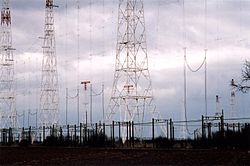 Since 1984 the CCIR has created a standardised nomenclature for describing curtain antennas, CCIR HF Transmitting Antennas consisting of 1 to 4 letters followed by three numbers:
 For example, a "HRS 4/5/0.5" curtain antenna has a rectangular array of 20 dipoles, 4 dipoles wide and 5 dipoles high, with the lowest row being half a wavelength off the ground, and a flat reflector behind it, and the direction of the beam can be slewed. An HRS 4/4/0.5 slewable antenna with 16 dipoles is one of the standard types of array seen at shortwave broadcast stations worldwide.
HRS antennaThe HRS type antenna is one of the most common types of curtain array. The name comes from the above CCIR nomenclature: it consists of an array of Horizontal dipoles with a Reflector behind them, and the beam is Steerable. These antennas are also known as "HRRS" (for a Reversible Reflector), but the extra R is seldom used. However, as far back as the mid-1930s, Radio Netherlands was using a rotatable HRS antenna for global coverage. Since the 1950s the HRS design has become more or less the standard for long distance (> 1000 km) high power shortwave broadcasting.  HRS descriptionAn HRS type antenna is basically a rectangular array of conventional dipole antennas strung between supporting towers.[8] In the simplest case, each dipole is separated from the next by 1⁄2 λ vertically, and the centres of each dipole are spaced 1 λ apart horizontally. Again, in the simplest case (for a broadside beam), all dipoles are driven in phase with each other and with equal power. Radiation is concentrated broadside to the curtain. Behind the array of dipoles, typically about 1⁄3 λ away there will be a "reflector" consisting of many parallel wires in the same orientation as the dipoles. If this was not present, the curtain would radiate equally forward and backward. Steering If there is an "S" in the antenna's designation, it is a steerable design. Following the ITU-recommendation, it might be called 'slewable design'.[7] This might be achieved electronically by adjustment of the electrical wave phases of the signals fed to the columns of dipole antenna elements, or physically by mounting the antenna array on a large rotating mechanism. An example of this can be seen at NRK Kvitsøy, where a circular railway carries a pair of wheeled platforms, each of which supports a tower at opposite ends of a diameter-arm. The curtain antenna array is suspended between the towers and rotates with them as the towers go around the circular railway. Another physical rotation technique is employed by the ALLISS system where the entire array is built around a central rotatable tower of great strength. Electrically slewed antenna arrays can usually be aimed in the range of ±30° from the antenna's physical direction while mechanically rotated arrays can accommodate a full 360°. Electrical slewing is typically done in the horizontal plane, with some adjustment being possible in the vertical plane. Azimuth beamwidth
Vertical launch angleThe number of dipole rows and the height of the lowest element above ground determine the elevation angle and consequently the distance to the service area.
Note that it is possible for details of the antenna site to wreak havoc with the designers plans such that takeoff angle and matching may be adversely affected. Examples of HRS antennasThis is an example of theoretical HRS design shortwave relay stations. This may help one better understand HRS antenna directivity.
Shortwave relay stations using only HRS antennasThis is an incomplete list of stations using only HRS antennas, sorted by country name. Active sitesBrazil
UK
Decommissioned sites
Germany
Spain
USA
RADAR Systems using HR Type Antennas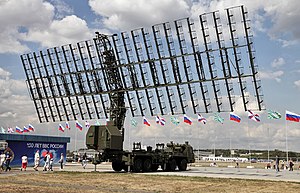 Some portable tactical antenna systems still use HR type antennas, mostly not HRS as the antennas are rotatable. References
External linksALLISS Technology portals |

